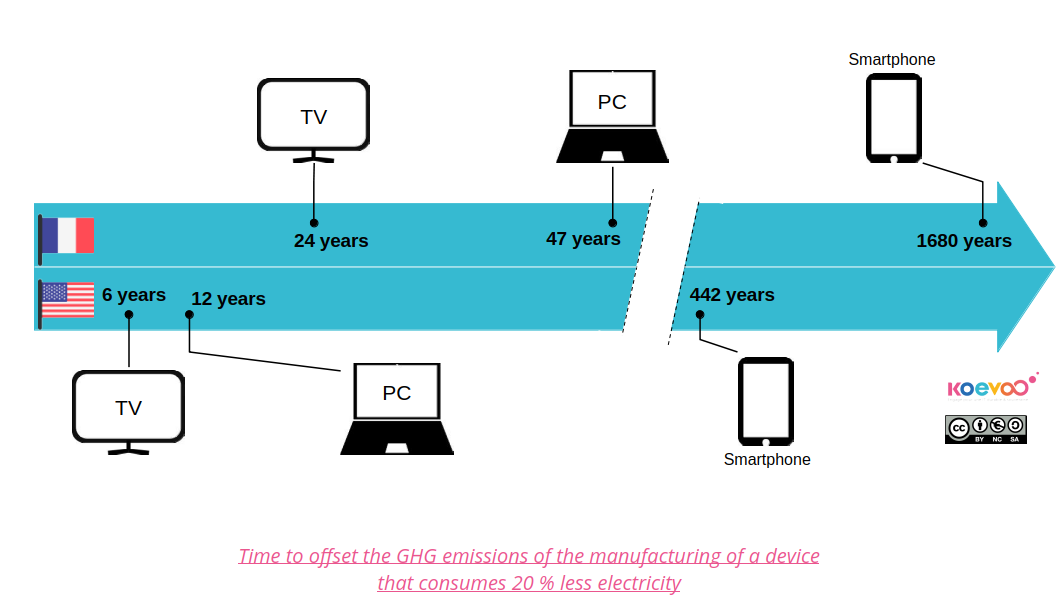Posted on
August 30th 2024
Changing your smartphone for an energy efficient model, an eco-friendly decision ?

New electronic devices are more and more powerful, they offer more and more features and, sometimes, they are more energy efficient than older models. Which is why, when you receive the latest promotional offer from your operator, offering to change your smartphone to a new model, it’s hard to resist. After all, if the newer model is more energy efficient, it is also an eco-friendly choice to buy it, right ? So, is it a good or bad idea ?
A smartphone, like any other elctronic device, generates an environmental footpront at every stage of its life cycle :
• the extraction of the raw materials necessary for its manufacturing generates pollution on several levels (extraction always remains necessary because we don’t know, and it seems that we’ll never know, how to recycle everything in a smartphone, particularly microelectronics)
• its distribution and use generate greenhouse gas (GHG) emissions,
• waste management also has an impact, however we won’t consider it here since we assume that the current smartphone is still fully functional and can therefore be reused without reconditioning.
The question is wether the energy savings achieved thanks to the new model are significant enough to offset the impacts of its distribution and manufacturing.
For greenhouse gas emissions, current knowledge indicates that, in France, the use of a smartphones accounts for less than 1 % of the total GHG emissions of the device(1). Thus, to offset the GHG emissions caused by the manufacturing of a new smartphone that is 20 % more energy efficient than the older model, it would take… 1680 years !

1680 years : This is how long it takes to offset the manufacturing of a new smartphone that is 20 % more energy efficient than the old model, when used in France.
But this result is a little different if we take a look at other countries, like the United States of America, where the carbon intensity of the electricity mix is higher than in France. It takes 442 years to offset the manufacturing of a new smartphone that is 20 % more energy efficient than the previous model, when charging is done in the USA.
These results also differ for other devices that consume more electricity to operate, such as our televisions. Indeed, for TVs, GHG emissions generated during the use phase can far exceed those of the manufacturing phase. For a new TV model that consumes 20% less power than its predecessor, it will take around 24 years in France to offset the GHG emissions from manufacturing, and 6 years in the USA.
One might thus think that, for certain devices and in certain countries, replacing your equipment is an eco-friendly action. However, whatever the country, replacing an electronic device is never ecologically profitable, because it is essential to keep in mind that the environmental impacts of our devices is not limited to the emission of GHG. And among other impacts (water, polution, …), the ever-necessary extraction of metals for manufacturing is critical because these non-renewable ressources are poorly, if at all, recyclable, particularly for microelectronics (microprocessor, memory, etc). Shortages could occur in 10 to 20 years according to some estimates (article to come on the subject).
In order to ensure sustainability, it is thus crucial to keep mineral extraction to a minimum. This is why it is essential to make our devices last as long as possible and, when we need to replace them, to choose a refurbished device !
💡 Tip !
Is your computer slow ? Instead of changing it, why not switch to a free operating system like Linux ! You’ll rediscover the joy of your computer’s performance when you first used it.
And if you’re afraid of having to type lines of code into a terminal, don’t worry, that’s been a thing of the past for some time now. And among the various shades (we call them “distributions”) that exist, the latest version 24.04 of the Ubuntu distribution will even give your machine a Mac look 😎.
(1) Data from datavizta.boavizta.org
© Picture Freepik, Flag icons Freepik, Flaticon.
Explore the data with Koevoo :
Calculations for the offset durations were done using data from datavizta.boavizta.org, providing estimates of the GHG emissions (in kg CO2 eq.) for the manufacturing phase (including extraction of raw materials) and the use of various devices.
Based on these data, offset durations are calculated using the following equation :
t = GHGmanufacturing/ (GHGuse x GHGreduc)
Where :
• t is is the number of years after which the reduction of GHG emissions during use is equal to the amount of GHG emitted during the manufacturing of the new device,
• GHGmanufacturing is the amount of GHG emitted during the manufacturing of the new device,
• GHGuse is the amount of GHG generated each year by the use of the device in a given country, for 7 hours of daily use.
• GHGreduc is the GHG emissions reduction factor during use thanks to the new device (20 % in the example of this article)
The offset durations calculated here are estimates and present a number of limitations. Some phases of the life-cycle, such as distribution, are not considered. Furthermore, the data on which the calculations are based are subject to uncertainty. In particular, datavizta.boavizta.org uses data from the impacts database of ADEME, for which uncertainty is quantified (data available on the ADEME website).
Other posts
Every post >Contact
Let's meet !
Thank you for reading our blog. If you wish to find out more, feel free to contact us.
Koevoo needs the contact details you provide to contact you about our products and services. You can unsubscribe from these communications at any time. See our Privacy Policy to learn more about how to unsubscribe, our privacy policies and our commitment to privacy.
